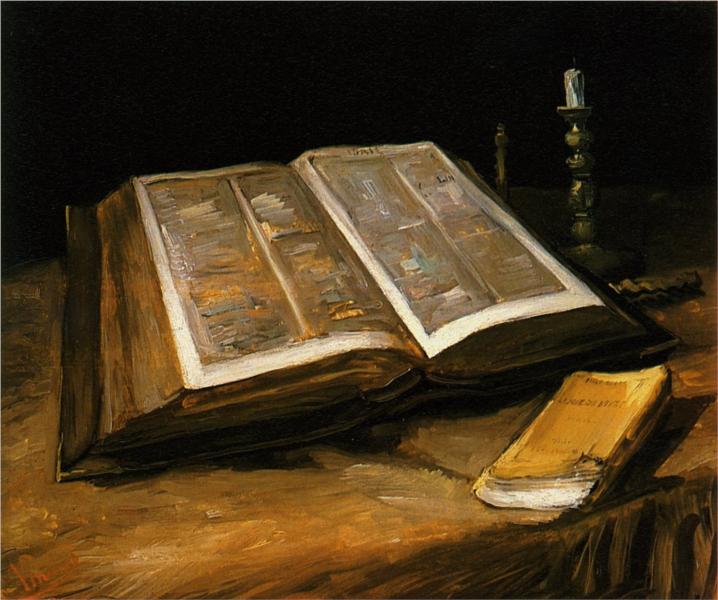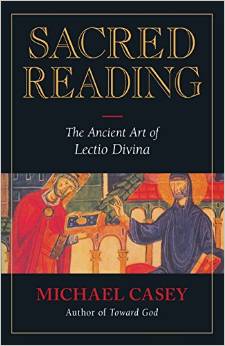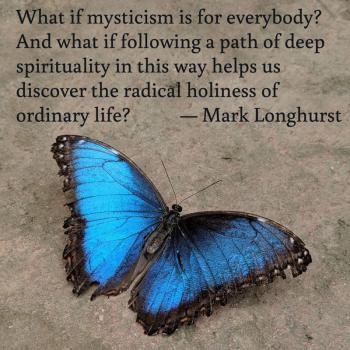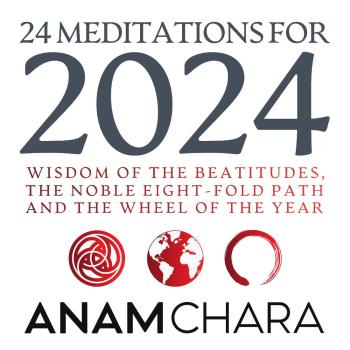
“Love for Jesus is fed by constant meditation on the Gospels.”
— Michael Casey, OCSO
A prominent pastor who hosts an Internet podcast once interviewed me for his show, and at the close of our conversation asked me, “What is the one book you would recommend to readers as the most essential title to read, for the purpose of understanding Christian mysticism?”
Without batting an eye I said, “The Bible, of course.” I don’t think that was the answer he was expecting!
But it’s true. If you had to limit your reading to just one book, then forget Meister Eckhart, forget Julian of Norwich, forget Teresa of Avila and John of the Cross, forget The Cloud of Unknowing, forget John Ruusbroec. As wonderful as all those authors are (and, yes, I commend these books to anyone who seeks to learn about, or engage in, mystical spirituality), they are all, fundamentally, simply commentaries on sacred scripture, which is the true essential textbook for the contemplative way.
Here’s the thing to keep in mind. Christian contemplation, unlike other forms of mystical philosophy, is ultimately about a relationship: or, perhaps better said, a web of relationships. God is love. Jesus gave us four essential challenges: to love that God who is love, and to love our neighbors, as we love ourselves, and if we really take him seriously, to love even our enemies. Love God, love neighbors, love self, love enemies. Since love is the glue that holds relationships together, Christian spirituality is a spirituality of relationships. And contemplation (or mysticism) is ultimately about fostering the relationship with God, the love we seek to give back to the Source of All Love, through silence, through meditation, through prayer, through contemplation.
And this is where the Bible comes in. The words of Sacred Scripture frame and support the silence of contemplation the way that a solid foundation provides the base for a beautiful building to stand. But that’s a two way street: the nurturing silence of mindfulness gives us the freedom and non-attachment necessary to read the Bible with contemplative eyes. Silence and the Word go together like the yin and the yang comprise the Tao.
Christian spirituality rests on the relationship we forge with Christ, in response to the Love of God. And we meet Christ in many ways — in the hearts of loved ones, in the Eucharist, in those in need. Scripture, likewise, is a solid and foundational way in which we encounter Christ. Through the words of the Bible, we are invited into the living heart of Christ, and we are called to invite Him into our hearts, as well.
Many Christians approach the Bible as if it were a textbook, or worse yet, a code of law, rather than a love letter. But the mystics and contemplatives have always understoood that the Bible is first and foremost about love, which is why their favorite book in the Bible has always been The Song of Songs, the juicy love poem at the heart of the Hebrew Wisdom Literature. Yes, we can read the Bible to learn about God (textbook), or to discover and apply God’s commandments in our lives (code of law) — but both of those approaches to scripture are meant to be subordinate to the invitation into love. For God is Love.
So put aside all ideas you might have about “studying” the Bible-as-textbook or Bible-as-code-of-law. Let me invite you into an ancient way of reading the Bible, a prayerful and meditative way, that emphasizes love and relationship, and helps us to foster that intimacy with God that we crave (even if we aren’t conscious of it). This method of Bible reading is called Lectio Divina (Latin for “sacred reading”).
Lectio Divina has been a part of Christian spirituality since at least the sixth century, and perhaps long before that. It is a beautiful way to integrate four essential practices: engaging with the Word of God as encountered in sacred scripture, meditating on the graces and mysteries of faith, prayer as a way of opening the thoughts of our mind and feelings of our heart to God, and resting in the vast open presence of contemplative silence. Lectio is an integral spiritual method which effortlessly weaves these four dimensions of devotion into one meaningful daily exercise.
A short treatise called The Ladder of Monks: A Letter on the Contemplative Life, written by the Carthusian Guigo II in the twelfth century, spells out a basic process for engaging in Lectio Divina, which still is eminently useful today. The heart of the practice is not so much what we do (or even the order in which we do it), but the way we approach the text we are reading.
- Lectio — Read — the key is to read slowly, prayerfully, meditatively. Linger over the words, savoring their message for you. Do not encumber yourself with Bible commentaries or other supplemental books — save those for study time. Rather, simply find a passage, a short passage, maybe even just one or a few verses, and read them slowly, attentively, mindfully. This is not a race. Read a passage, and reread it. You can keep reading until it seems that a particular word or phrase is speaking to you, but stop then. Allow a sacred pause. Take a few relaxing breaths. Now you are ready to move to the next step:
- Meditatio — Reflect — traditionally, meditation in a Christian sense involved the process of reflecting on a word or teaching or one of the mysteries of the faith. Allow yourself to sit with the word or phrase that has spoken to you. Feel whatever feeling it elicits in you. Ponder what questions it asks of you. Perhaps you feel blessed or inspired, or confused or challenged or convicted. Simply let the Word of God speak to you. At this point, it’s less about you reading the Bible, and more about the Word of God “reading” you. Sooner or later, every conversation involves give-and-take, so at some point you’l be ready for the next step:
- Oratio — Respond — God reveals Divine Love to us through sacred scripture, and now we are asked to reveal the hidden depths of our hearts and minds to God through prayer. Of course, God already knows the hidden places in our hearts and minds, but it is a blessing to us to consciously seek to hold those secret dimensions into the Light of Love. Pray to God, in response to the words you have read and the reflections you have pondered. You don’t have to be eloquent or fancy in your prayer. It could be as simple as “God, I love you” or “Lord, today’s reading really confused me/upset me.” Be honest with God. Express your doubts, your longings, your desires, your fears, your dreams. Express adoration and devotion, of course; confess sins when that is necessary as well. Take however long you need to share your mind and heart with the God Who is Love. This doesn’t need to last forever (it might only take a minute or two). You’ll sense when you have prayed all you need to pray, at least in terms of thoughts and feelings. Then it is time for the final step:
- Contemplatio — Rest — “Be still and know that I am God,” speaks the Lord in Psalm 46; in other verses in the Psalms we are invited to let our souls rest for God in silence and even to recognize that silence itself is praise. We begin the process of Lectio Divina by seeking the Word of God through the Bible, and we end by seeking the silence of God through contemplative prayer, the prayer of restful, attentive silence. Here we “do” nothing more than breathe gently, allowing our thoughts and feelings to come and go without commentary or attachment. We can use a prayer word or verse (my favorite, again from the Psalms, is “O God, come to my assistance; O Lord, make haste to help me”) as a way of focussing our mind/heart so that we are less likely to be distracted by distractions during this period of rest. This is like a “Sabbath” prayer: we seek to grow in love of God simply by resting in God’s heart, the way a small child rests on her mother’s lap. We let go, and let God. We praise God simply by resting in silence, trusting in God’s love to hold us.
So that is the process of Lectio Divina. Monks and nuns and other Christians with a lively thirst for God have engaged in this simple prayer practice for centuries, giving some time every day to the adventure of falling ever more deeply in love with God through reading the Bible, reflecting on the Word, responding to God in prayer, and then resting in Divine Love and silence.

I encourage you to give it a try. Today is a good day to start. If you would like to learn more about Lectio Divina, here are a few books for further reading:
- Sacred Reading: the Ancient Art of Lectio Divina by Michael Casey, OCSO;
- Lectio Matters: Before the Burning Bush by Mary Margaret Funk;
- Too Deep for Words: Rediscovering Lectio Divina by Thelma Hall.
For a Bible, I recommend staying away from Study Bibles or Bibles filled with notes that will encourage you to approach it like a textbook rather than a love letter. My favorite Bible for Lectio is the Saints Devotional Edition, available in the New Jerusalem Bible translation or the New American Bible Revised Edition. And since I’m at the age where my eyes prefer larger type Bibles, I also enjoy using the New Revised Standard Version with Extra-Large Type (!).
Enjoy Lectio. It’s meant to be a joy, not a chore. Remember the reason for doing it: to discover the love of God, and to let that love transfigure your heart.
Enjoy reading this blog?
Click here to become a patron.














